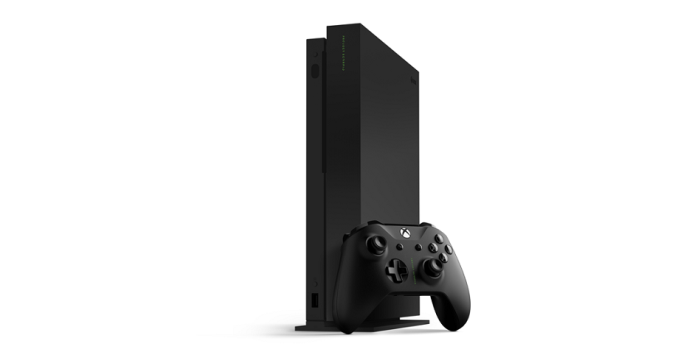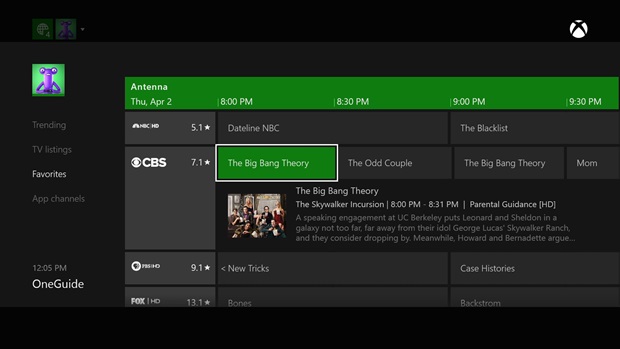The Xbox One X Review: Putting A Spotlight On Gaming
by Brett Howse on November 3, 2017 3:01 AM EST- Posted in
- Consoles
- Microsoft
- Xbox One
- Xbox
- Xbox One X
Power Usage
There’s a lot of performance on tap in the Xbox One X, which never comes with no strings attached. Like the Xbox One S, the APU inside is built on TSMC’s 16 nm FinFET process, which should help keep power usage under control. In addition, the Xbox One X is outfitted with a power supply that Microsoft equates to an 80 Plus Gold unit, which means it should be 90% efficient at 50% load with a 115 V source, and there shouldn’t be too much extra power wasted from the PSU converting AC voltage.
There’s several scenarios we tested for power usage:
Off – Xbox One X is powered off in Energy Savings mode, which means standby mode is disabled.
Standby – Xbox One X is powered off in Instant-On mode, which allows background updating and voice activation enabled (if supported).
Idle – Ethernet connected, no disc in the drive, system idling at dashboard.
Load (UHD BD Playback) – Ethernet connected, UHD Blu-Ray disc in the drive playing Planet Earth II, compared to The Hobbit on Blu-Ray on the original Xbox One.
Load (GoW4) – Ethernet connected, no disc in the drive, playing Gears of War 4 in UHD/HDR.
Load (The Wolf Among Us) – Ethernet connected, no disc in the drive, playing The Wolf Among Us in FHD SDR.
We’ve been able to compare against the original Xbox One, although not the S model as we didn’t have one on hand. The Wolf Among Us was chosen as an older game which caps at 1080p and SDR, and Gears of War 4 shows the power draw at full 4K HDR rendering. The comparison against the original for this game will of course be for the 1080p version though, since that’s the max it supports.
| Power Consumption Comparions | |||||||
| Total System Power | Energy-Saving | Instant-On | Idle | Load (UHD BD) | Load (GoW4) | Load (The Wolf Among Us) | |
| Xbox One | < 2W | 14.2W | 53W | 80W | 107W | 102W | |
| Xbox One X | < 1W | 10W | 56W | 64W | 172W | 101W | |
As with the original Xbox One, when Instant On is disabled, the console is practically fully off. There’s a small amount of draw, but overall, not very much. Most people that use the console are going to likely want it in Instant On mode though, so games and the console can update while the system is off, as well as to provide a much quicker startup time, and games can remain loaded in RAM. In Standby mode, power draw is reasonable at 10 W, which is lower than the original console when it first launched. It’s still a fair bit of power, but when you factor in that it needs to keep 12 GB of GDDR5 memory powered up (among other things), it is not unreasonable to expect this amount of power draw.
Idling at the dashboard draws around 55 W, and to add to that, most non-gaming tasks don’t add very much to this total, if any. If you’re using your Xbox to passthrough HDMI from a cable box, it will take this same power draw. Maybe this would be an impossible pipe dream, but it would be nice to see the Xbox One also pass through HDMI when it is in Standby mode.
Playing back a UHD Blu-Ray (standard Blu-Ray on the original Xbox One) was a tiny bit higher than idle, which is good to see. Some of the draw would be the disc drive itself, but a lot of the playback would be offloaded to fixed function hardware in the media block so it’s not surprising to see it so close to idle.
Clearly gaming on older Xbox One games is not much of a chore for the Xbox One X, since the power draw is only about 50 W over idle. But, when gaming with an Xbox One X Enhanced title, such as Gears of War 4, the power draw jumps significantly to 172 W as the peak observed. This is quite a jump over the original console, and makes the cooling system, which is barely audible even under these loads, even more impressive. Compared to a high-end gaming PC though, the power draw is quite a bit less.












128 Comments
View All Comments
Lolimaster - Sunday, November 5, 2017 - link
Not Vega. Navi + Zen3 cores @7nm+ (probably a 6cores/12threads APU).Rufnek - Monday, November 6, 2017 - link
*cough*.Try to keep in mind they have to plan the consoles 3-5 years in advance. The next consoles will likely be a low power Ryzen (v1.5+) with a low power Vega (v1.5+). The .5 is for low power, smaller circuit refresh, the + is for specialized items in the CPU/GPU.
Hixbot - Friday, November 3, 2017 - link
I'm also disappointed with the CPU on Xbox One X. In my opinion the biggest flaw with PS4 and Xbox One is the CPU performance. A developer needs to sacrifice alot to hit 60fps, because of the poor CPUIf Xbox One X leveraged a Ryzen based APU, it would have been a 100% CPU performance increase, which would have been enough to push games that were CPU limited to 30fps to 60fps.
The 30% CPU overclock on the Xbox One X will not be enough to boost 30fps games to 60fps.
Frankly the massive GPU upgrade will allow much higher resolutions, in which is something I'm not really interested, but will not allow better framerates on CPU limited games, which is much more important to me.
InlineV - Friday, November 3, 2017 - link
It is worth noting that DirectX draw calls are no longer CPU bound. That function has been integrated, at the hardware level, into the GPU. That mitigates a potential bottleneck. Arguably, it is one of the most interesting innovations in the One X. It may never make it into commodity PC hardware but it would be significant if it did.dogen1 - Friday, November 3, 2017 - link
Technically the Xbox one already had this feature, or part of the same feature built into the GPU command processor.tipoo - Friday, November 3, 2017 - link
The article says it's still split with the GPU command processor and the CPU, but that the more powerful CP this time allows more functions to move to it.Alexvrb - Friday, November 3, 2017 - link
The CPU isn't going to hold it back in gaming. Also, this custom SoC was in development for some time before they ever started cranking them out. Redesigning it for Zen cores would have delayed it until sometime next year... and for what? More CPU horsepower isn't going to magically net them 60 FPS in gaming scenarios which are largely GPU-bound. Plus it would further complicate backwards compat (frankly I was shocked the lack of eSRAM didn't hurt them more in that department).Can't wait to see an in-depth look at all the interesting little custom bits. See InlineV's post. I want to read more about additions like that.
franzeal - Friday, November 3, 2017 - link
You'd be wrong. There are plenty of games (Assassin's Creed Unity a glaring example):https://www.youtube.com/watch?v=ZJmWsgFl6kA
StevoLincolnite - Saturday, November 4, 2017 - link
Digital Foundry has done a good game breakdown already. The CPU most certainly is a hindrance.Rufnek - Monday, November 6, 2017 - link
Digital Foundry reads like a fluff piece. Very disappointed as I tend to lean on their technical reviews.Want an actual review of good & bad and questions still unanswered... then read this.
https://arstechnica.com/gaming/2017/11/xbox-one-x-...